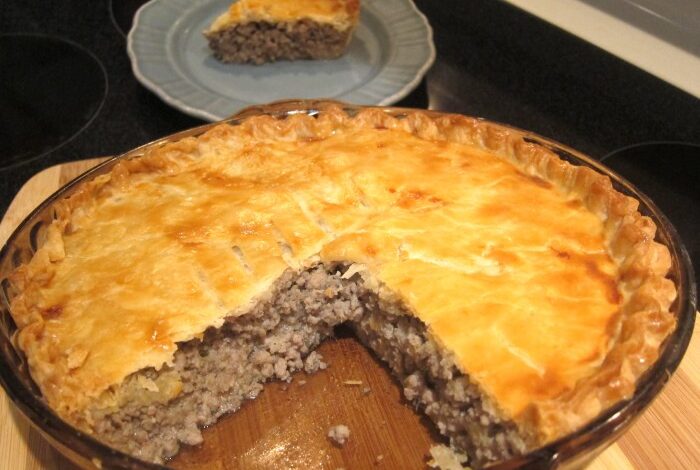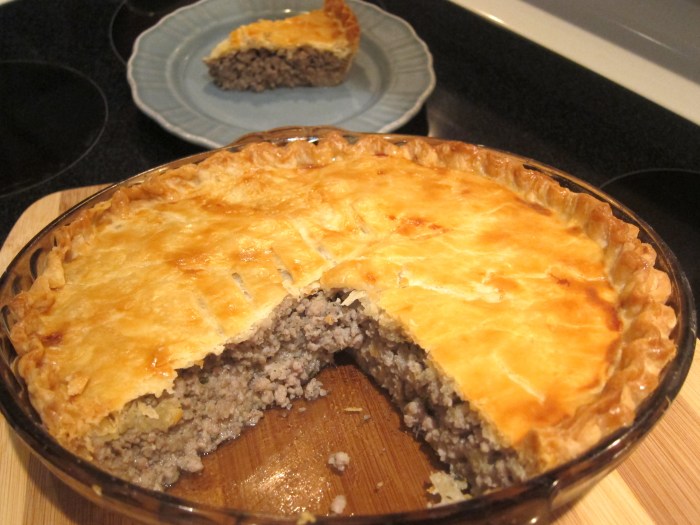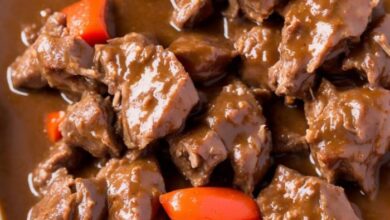
Tourtière: French Canadian Meat Pie, A Culinary Tradition
Tourtiere french canadian meat pie – Tourtière, French Canadian meat pie, is a dish deeply rooted in the history and culture of Quebec. It’s more than just a meal; it’s a symbol of family, tradition, and celebration. This hearty pie, filled with savory ground meat, spices, and often potatoes, has been a staple in French Canadian homes for centuries, its origins tracing back to the early settlers of the region.
The recipe for tourtière has evolved over time, incorporating local ingredients and adapting to the changing culinary landscape. From the classic pork and beef filling to modern variations using venison or even vegetarian options, tourtière continues to be a versatile and beloved dish, enjoyed throughout the year but especially during the holidays.
History and Origins of Tourtière

Tourtière, a savory meat pie, is a beloved staple of French Canadian cuisine. Its origins can be traced back to the early days of French colonization in Canada, where it played a vital role in the sustenance and cultural identity of the settlers.
This dish, with its humble beginnings and rich history, continues to be a cherished tradition in French Canadian households, passed down through generations.
Early French Canadian Settlers and the Origins of Tourtière
The origins of tourtière are deeply intertwined with the arrival of French settlers in Canada in the 16th and 17th centuries. These early pioneers, facing harsh conditions and limited resources, relied heavily on hunting and foraging for their survival. They incorporated local ingredients, including wild game, into their cuisine, leading to the development of dishes like tourtière.
The dish’s name, “tourtière,” derives from the French word “tourte,” meaning “pie.” The early versions of tourtière were simple, consisting of a filling of ground meat, often wild game like venison or rabbit, mixed with onions and spices, enclosed in a pastry crust.
The Evolution of Tourtière: From Survival Food to Festive Tradition
Over time, tourtière evolved from a simple survival food into a more elaborate and festive dish. As French Canadian society developed and agriculture became more established, the ingredients used in tourtière expanded to include domesticated meats like pork and beef.
The addition of spices like cloves, nutmeg, and cinnamon, brought in by European traders, added a touch of sophistication to the dish. Tourtière also began to be served on special occasions, becoming a central part of traditional celebrations like Christmas and New Year’s Eve.
Cultural and Social Factors Shaping Tourtière, Tourtiere french canadian meat pie
Several cultural and social factors influenced the development of tourtière:
- Availability of Ingredients:The early French Canadian settlers were limited to the ingredients available in their environment. This led to the use of wild game and local vegetables, shaping the early versions of tourtière.
- Sharing and Community:Tourtière was often made in large quantities and shared among families and communities. This practice reinforced social bonds and promoted a sense of community.
- Cultural Identity:As French Canadian culture evolved, tourtière became a symbol of heritage and identity. It was a dish that connected people to their roots and traditions.
Traditional Ingredients and Preparation
Tourtière, the iconic French Canadian meat pie, boasts a rich history and a traditional recipe that has been passed down through generations. Its ingredients and preparation methods reflect the resourcefulness and culinary heritage of the region.
Tourtière, the classic French Canadian meat pie, is a hearty and comforting dish that evokes memories of cozy winter evenings. While it’s a far cry from the sweetness of dessert, I can’t help but think of another kind of comfort food that brings a similar warmth – the amazing passover chocolate toffee matzo.
This unique dessert, a delightful twist on tradition, reminds me of the unexpected joy that can be found in embracing new flavors. Both tourtière and this decadent matzo creation are testaments to the power of food to bring people together, no matter the season or occasion.
Traditional Ingredients
The heart of a traditional tourtière lies in its carefully chosen ingredients. While variations exist, the core elements remain consistent.
- Meat:Traditionally, tourtière is made with a combination of ground pork and beef. The ratio of pork to beef can vary depending on regional preferences and personal taste. Other meats, such as veal or venison, can also be incorporated.
Tourtière, the iconic French Canadian meat pie, is a comforting classic that always brings back memories of family gatherings. While tourtière is traditionally served with a flaky crust, I recently discovered a fun twist on the concept: stuffed jack o lantern bell peppers.
These festive peppers offer a similar savory filling, but with a playful presentation. The key to both dishes is the rich, flavorful meat filling, and I’m sure you’ll find the unique presentation of the peppers adds a touch of fun to your next meal.
- Spices:The spice blend is what gives tourtière its distinctive flavor. Common spices include allspice, cinnamon, cloves, nutmeg, and black pepper. Some recipes also call for a touch of cayenne pepper for a subtle kick.
- Vegetables:Onion, celery, and potatoes are the traditional vegetables used in tourtière. These vegetables are finely chopped and sautéed before being added to the meat mixture.
- Broth:Beef or pork broth is added to the meat mixture to create a flavorful and moist filling.
- Pastry:A rich, flaky pastry crust is essential for a true tourtière. Traditional recipes use a simple dough made with flour, butter, salt, and water.
Traditional Preparation Methods
The preparation of tourtière involves several steps that ensure a delicious and authentic pie.
- Preparing the Filling:The meat is ground and seasoned with spices. The vegetables are finely chopped and sautéed until softened. The meat, vegetables, and broth are then combined and simmered until the flavors meld.
- Making the Crust:The pastry dough is rolled out and fitted into a pie plate. The edges are crimped and the dough is pricked with a fork to prevent air bubbles from forming.
- Assembling the Pie:The meat filling is poured into the pie crust. The top crust is rolled out and placed over the filling. The edges are crimped to seal the pie.
- Baking:The tourtière is baked in a preheated oven until the crust is golden brown and the filling is cooked through.
Modern Variations
While traditional recipes are cherished, modern variations of tourtière have emerged. These variations often incorporate new ingredients and techniques, while still honoring the essence of the dish.
- Ingredient Substitutions:Some modern recipes use ground turkey or chicken instead of pork and beef. Other variations include the addition of ingredients like mushrooms, cranberries, or apples.
- Cooking Methods:Some modern cooks use slow cookers or pressure cookers to prepare the meat filling, which can help to tenderize the meat and enhance the flavor.
- Presentation:Modern variations may feature different crust designs or be served with side dishes like cranberry sauce or mashed potatoes.
Significance and Cultural Importance: Tourtiere French Canadian Meat Pie
Tourtière, a beloved French Canadian meat pie, holds a special place in the hearts and kitchens of many. More than just a delicious dish, it embodies a rich culinary history and cultural significance that has been passed down through generations.
Role in Celebrations and Gatherings
Tourtière is a staple at many French Canadian celebrations, holidays, and family gatherings. Its presence is a symbol of warmth, togetherness, and shared traditions.
- Christmas Eve:In many French Canadian homes, tourtière is a centerpiece of the Christmas Eve feast, known as Réveillon. It’s a tradition that dates back centuries, representing the abundance and joy of the holiday season.
- Family Reunions:Tourtière is often prepared for family reunions and gatherings, bringing people together around a shared table. It serves as a reminder of family history and the importance of preserving traditions.
- Weddings and Baptisms:Tourtière is also a popular choice for weddings and baptisms, symbolizing the celebration of new beginnings and the sharing of blessings.
Symbolic Meaning and Cultural Values
Tourtière represents more than just a delicious meal; it embodies the spirit of French Canadian culture and values.
- Generosity and Hospitality:Sharing a tourtière with loved ones is a way to express generosity and hospitality, a core value in French Canadian culture.
- Resourcefulness and Simplicity:The use of readily available ingredients and simple preparation techniques reflects the resourcefulness and practicality of French Canadian heritage.
- Connection to the Land:The use of local ingredients, like pork and spices, connects the dish to the land and the traditions of French Canadian farmers and settlers.
Modern Interpretations and Innovations
While tourtière remains a cherished tradition, contemporary chefs and restaurants are embracing its versatility and reinterpreting it for modern palates. This evolution reflects the dynamic nature of French Canadian cuisine, which blends classic recipes with innovative techniques and ingredients.
Contemporary Interpretations of Tourtière
Contemporary chefs are pushing the boundaries of tourtière, exploring new flavor combinations and presentation styles.
- Modern fillings:Instead of the traditional pork and beef, chefs are experimenting with duck confit, venison, or even vegetarian options like lentils and mushrooms. These variations retain the essence of tourtière while catering to diverse dietary preferences.
- Spice and Flavor Profiles:Modern interpretations often incorporate bold spices like harissa, chipotle, or ginger, adding layers of complexity and heat to the traditional filling.
- Elevated Presentation:Gone are the days of the humble pie dish. Chefs are presenting tourtière in elegant, modern forms, such as individual tartlets, puff pastry cups, or even deconstructed plates with components of the filling arranged artistically.
Tourtière in Contemporary French Canadian Cuisine
Tourtière is not just a nostalgic dish; it’s a source of inspiration for contemporary French Canadian cuisine.
- Fusion Dishes:Chefs are blending tourtière elements with other culinary traditions, creating innovative dishes like tourtière-inspired dumplings, tacos, or even sushi rolls. This fusion approach showcases the adaptability of tourtière and its potential to inspire new culinary creations.
- Elevated Ingredients:Modern chefs are using high-quality, locally sourced ingredients to elevate the traditional tourtière. For example, using heritage breed pork or organic vegetables enhances the flavor and supports local farmers.
- Seasonal Variations:Tourtière is no longer confined to the winter months. Chefs are creating seasonal variations, using fresh, seasonal ingredients to highlight the flavors of each season. For example, a summer tourtière might feature fresh berries and herbs, while a fall version could incorporate root vegetables and squash.
Serving and Enjoyment
Tourtière, a quintessential French Canadian dish, is not just a culinary delight but also a symbol of tradition and warmth, best enjoyed in a convivial setting. Its rich flavors and hearty texture are meant to be shared and savored, with each bite transporting you to the heart of Quebec’s culinary heritage.
Traditional Serving Styles
The traditional way to serve tourtière is in generous slices, accompanied by a selection of classic French Canadian side dishes that complement its savory notes.
- Mashed potatoes:Creamy and comforting, mashed potatoes provide a perfect counterpoint to the richness of the tourtière filling.
- Pickled beets:The tangy sweetness of pickled beets adds a refreshing contrast to the savory pie.
- Cranberry sauce:A classic pairing for many savory dishes, cranberry sauce adds a touch of tartness and sweetness to the tourtière.
- Green beans:Steamed or sautéed green beans provide a light and healthy accompaniment.
- Pea soup:In some regions, pea soup is served alongside tourtière, creating a hearty and satisfying meal.
Optimal Enjoyment
Tourtière is best enjoyed warm, allowing the flavors to fully develop and the crust to achieve a delightful crispness.
“A good tourtière should be served hot, with a crust that is golden brown and flaky, and a filling that is rich and flavorful.”
The ideal serving size is one generous slice, enough to satisfy without being overwhelming.
Serving Tourtière for Various Occasions
Tourtière is a versatile dish that can be served for a variety of occasions, with presentation styles adapted to suit the occasion.






